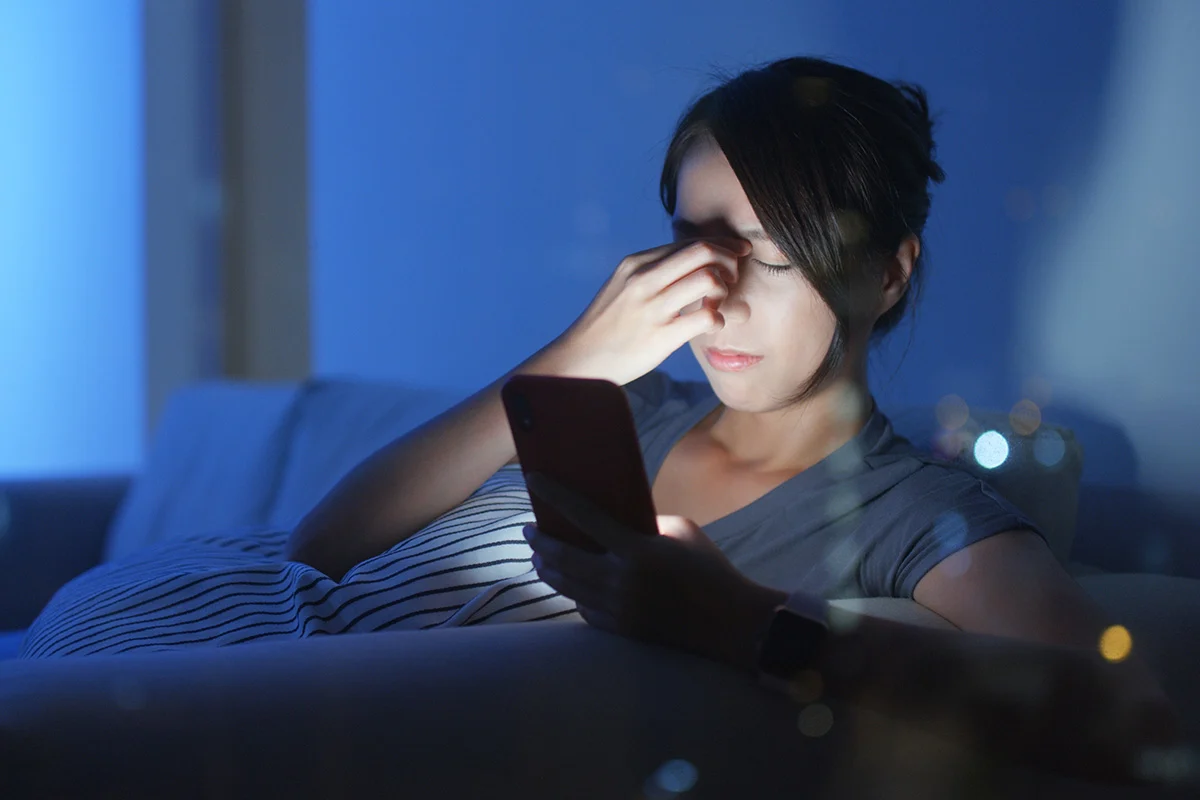Despite its name suggesting otherwise, cellular phones aren’t supposed to have anything to do with the cells that make up our bodies—but current research points to some very unfortunate links between our health and the smartphones we can’t seem to live without.
The term “cellular” was coined in the 1970s and was originally meant to refer to the network of wireless towers, which developers likened to the human body’s cellular layout. Your cell phone is actually a mobile device, a term that predates the cellular misnomer by about 30 years. But the term “cell phone” stuck and now Americans almost never refer to it as a mobile device.
Whether you call it a cell phone, mobile device, or smartphone, there’s a good chance you are either reading this article on one right now or it’s nestled against your body inside your pocket or next to your hand on your desk. The glow of the cell phone screen is the first thing too many of us see in the morning and all too often the last thing we see at night. Stuck in a seemingly constant state of scrolling, we are attached to our phones for work, for goofing off while at work, and while unwinding after a long day of work.
Beyond simple communication, smartphones have given us a world of information literally at our fingertips. It’s a power that previous generations never could have dreamed of possessing—but is all that power starting to catch up with us?
Cell Phone Technology And Where It’s Going
To grasp why there is even the possibility that cell phones might present health concerns, we need to have a general understanding of the mechanisms at work when we make a call, send a text, or explore the Internet. In the simplest of terms, cell phones and smartphones are like handheld radios, sending and receiving signals over radio waves.
The signals from your phone are transmitted via a series of towers, each covering a specific area in a network. An outgoing call goes from your nearest tower, to the nearest tower of whomever you are calling. And if you are on the move, the signal switches from tower to tower as you go without interrupting the call (in theory, anyway). The process is similar to when you browse the web or make a file transfer or play games on your smartphone.
That smartphone technology, which has progressed at lightning speed over the last few years, is classified into generations. We are currently in the fourth generation (4G) of cell phone technology—and 5G is just over the horizon. That fifth generation of cellular science, while rolling out slowly, should be widespread by 2020. It has the potential to be the most technologically advanced communication effort in human history. In fact, its impact is expected to be so immense that weather experts worry about its effects on the accuracy of weather forecasting systems, including severe weather like hurricanes and tornadoes.
And if it could potentially interfere with our advanced meteorological equipment, what types of havoc might 5G, 4G, and those simple radio waves have on your body as you sit with your phone in your pocket or pressed up against your ear? And what does staring at the hypnotic glow of your cell phone, computer or tablet screen do to your eyes?
Health Concerns Associated With Mobile Phones
Oxidative Stress
While health effects are still under investigation, the ubiquitous use of cell phones has accelerated the spread of radiofrequency electromagnetic fields, and it is this phenomenon that has some experts concerned. The World Health Organization (WHO) has examined the risks associated with mobile phones, as well as phone base stations, to determine the validity of various news reports. According to officials, it is a question the organization takes very seriously.
“Given the immense number of people who use mobile phones, even a small increase in the incidence of adverse effects on health could have major public health implications,” the WHO said in 2013.
The organization’s research mainly focused on mobile phone handsets, rather than base stations, because exposure to radiofrequency (RF) fields is generally more than 1,000-times higher with phones, meaning there is a greater likelihood of adverse health effects. The research shows that these radiofrequency fields could harm to your cells and DNA, along with posing a risk of oxidative stress on your cells (the ones in your body) while compromising cognitive function.
“Based on mixed epidemiological evidence...RF fields have been classified by the International Agency for Research on Cancer as possibly carcinogenic to humans,” said the WHO. The organization concluded that the increasing use of mobile phones and the lack of data for use over time exceeding 15 years warrant further research into the impact it could have on brain health, especially for heavy cell phone users.
The main cause of concern, according to research, is the ability of radiofrequency fields (or electromagnetic radiation) produced by cell phones and cell towers to cause oxidative stress by increasing free radicals in the body. (Free radicals are rogue cells in the body that attack healthy cells and tissues.)
And more research shows that along with oxidative stress, the radio waves associated with cell phones could increase skin temperature, alter gene expression, cause the proliferation of inflammation, and damage the eyes. With all of these health implications, it may be time to re-evaluate our relationship with cell phones, and to of course look at ways to mitigate the potential harm.
Vision & Eyesight Problems
Risks associated with vision might be the most obvious side effect of cell phone usage, particularly smartphones, along with computer and tablet screens. In what could only be described as a “modern day ailment,” the American Optometric Association (AOA) describes a certain group of eye and vision-related problems such as Computer Vision Syndrome or Digital Eye Strain. This problem arises from prolonged use of anything with a digital screen, and is manifested in symptoms like eyestrain, headaches, blurred vision, dry eyes, and even neck and shoulder pain.
“The average American worker spends seven hours a day on the computer either in the office or working from home,” the AOA said, though factoring smartphone usage into the equation exponentially increases that number of hours. “Viewing a computer or digital screen often makes the eyes work harder. As a result, the unique characteristics and high visual demands of computer and digital screen device viewing make many individuals susceptible to the development of vision-related symptoms.”
One of the main culprits in vision damage due to screen usage is the technological byproduct known as “blue light.” The largest source of blue light is the sun. But when combined with the rest of the natural light spectrum, the power of blue light is a mere footnote on the light spectrum (Roy G. Biv) range. But, here on Earth, blue light emits from fluorescent and LED lights, along with flat-screen LED televisions, and computer monitors, smartphones, and tablet screens. While the amount of blue light from these devices is small relative to the sun, the concentration of it combined with the close proximity of the screens to our eyes and the length of time we spend staring into it are factors that raise the concerns of researchers.
As for how blue light specifically affects the eyes, it passes through the cornea and lens, reaching the retina where it could disturb vision and prematurely age the eyes. Too much exposure can damage those light-sensitive cells in your retina in ways resembling that of age-related macular degeneration. In fact, several researchers have proposed that the amount of blue light received during an individual’s entire lifespan can be an important factor in the development of that irreversible eye condition, all though studies are inclusive as to impact of blue light on the risk of macular degeneration.
What Nutritional Efforts Answer The Call To Combat Cell Phones-Related Health Concerns?
The Effect Of Antioxidants On Oxidative Stress And Vision Health
A powerful antioxidant can be the natural enemy of oxidative stress-causing free radicals. Antioxidants bind themselves to those troublesome free radicals, halting their effects to steal electrons from other molecules in your body. Antioxidants, as you are well aware, are found in an abundance of foods, herbs, and other substances including green tea, turmeric, coenzyme Q10 (CoQ10), black seed oil, astaxanthin and more. According to one study, antioxidants are skilled free radical scavengers, hydrogen and electron donors, peroxide decomposers, singlet oxygen quenchers (especially astaxanthin, which can be 6-times more powerful than Vitamin C in this respect), and enzyme inhibitors—which all adds up to what is your body’s best defense against oxidative stress.
As for brain health in particular, support may be found in Ginkgo biloba. The world-famous botanical boasts qualities as an antioxidant that could increase energy production in brain cells, decrease cell-damaging free radicals, and increase blood flow to the brain, which brings in crucial nutrients and oxygen.
When it comes to support for vision health—lutein and zeaxanthin—which are found in the lens, retina, and macula of your eyes—are two carotenoids that researchers are very interested in exploring further for their eye health benefits. Studies have shown both can potentially reduce the risk of chronic eye diseases like age-related macular degeneration (AMD) and cataracts. How and why these carotenoids support the eyes once again comes down to the battle between antioxidants and free radicals. Oxidation causes cataracts to occur on your eye’s lens, and studies show that the antioxidant properties of lutein and zeaxanthin work to prevent this. Meanwhile, these nutrients could potentially help to slow the vision loss associated with AMD.
Where Do We Go From Here?
One thing is for sure, cellular technology is always going to advance, never regress. 5G will eventually give way to 6G, which is merely a precursor to 7G, 8G, and beyond. And as much as that is for certain, so is the fact that your body and its natural defenses need all the help it can get to counteract the effects of our ever-advancing technological world. So, if you’re going to be attached to your cell phone, computer, and/or tablet, then it will benefit your health to form a relationship with nutrients like lutein, Astaxanthin, CoQ10, and Ginkgo Biloba, along with plenty of antioxidant-rich fruits and vegetables.









